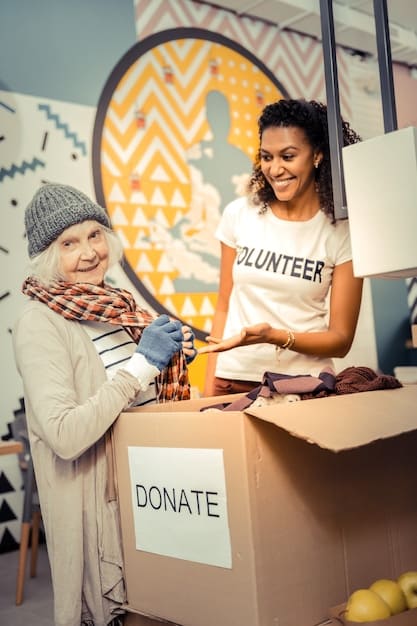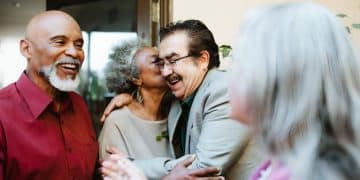Psychology of Altruism in the US: Motivations & Impact

Explore the intricate psychological drivers behind altruism in the United States, delving into various motivations ranging from empathy to social recognition that underpin helping behaviors across diverse demographics and situations.
Exploring the Psychology of Altruism: What Motivates Helping Behavior in the US? delves into one of humanity’s most intriguing and debated behaviors. Understanding why people choose to help others, often at a personal cost, offers profound insights into human nature and societal function. This article seeks to unpack the complex psychological underpinnings of altruism specifically within the American context.
The Nature of Altruism: Defining Unselfish Acts
Altruism, at its core, refers to selfless concern for the well-being of others. It involves acting to promote someone else’s welfare, even when there is no direct benefit to oneself and, in some cases, even when there’s a risk. This fundamental concept is central to understanding prosocial behavior, which encompasses any act performed with the goal of benefiting another person.
However, truly defining “altruism” can be complex. Is an act truly altruistic if the giver experiences a good feeling, or if the act enhances their social standing? Psychologists often differentiate between “pure” altruism, where the sole motivation is to benefit others, and more nuanced forms where personal benefits, even if subconscious, might play a role. Exploring this distinction is crucial when analyzing motivations for helping behaviors.
Evolutionary and Biological Roots
From an evolutionary perspective, altruism might seem counterintuitive. If survival of the fittest dictates that individuals should prioritize their own genetic propagation, why would helping others, especially non-relatives, persist? Theories like kin selection suggest that helping close relatives enhances the survival of shared genes. Reciprocal altruism proposes that helping others increases the likelihood of receiving help in return, fostering cooperation within groups.
Biological factors also play a role. Neuroscientific studies have shown that engaging in altruistic acts activates reward centers in the brain, releasing feel-good chemicals like dopamine and oxytocin. This “helper’s high” can reinforce helping behaviors, creating a positive feedback loop. Understanding these inherent biological predispositions provides a foundational layer to the more complex psychological and social motivations.
- Kin Selection: Helping blood relatives ensures the propagation of shared genes.
- Reciprocal Altruism: Mutual exchange of aid, expecting future returns.
- Neurochemical Rewards: Brain’s reward system activated by prosocial acts.
- Early Socialization: Learning empathy and helping from childhood experiences.
Ultimately, the nature of altruism in the US, as in other societies, is a blend of innate predispositions and learned behaviors. While we might be wired to some extent for prosociality, the specific forms and frequencies of helping are heavily influenced by cultural norms, personal experiences, and situational factors.
Empathy as a Primary Motivator for Aid
Empathy is often cited as one of the most powerful motivators for altruistic behavior. It’s the ability to understand and share the feelings of another. When we empathize with someone in distress, we feel their pain, sorrow, or need, which in turn can compel us to act to alleviate their suffering. The “empathy-altruism hypothesis,” proposed by Daniel Batson, suggests that true altruism is primarily driven by empathic concern.
In the US, where individualistic tendencies are often highlighted, empathy still plays a significant role in fostering community support and charitable giving. From responding to natural disasters to aiding individuals experiencing homelessness, the ability of Americans to put themselves in another’s shoes frequently sparks collective action. Visual media, personal stories, and direct exposure to suffering often heighten empathic responses, leading to increased helping behavior.
Cognitive and Emotional Empathy
Empathy itself has two main components: cognitive empathy and emotional empathy. Cognitive empathy involves understanding another person’s perspective and feelings intellectually, sometimes referred to as “perspective-taking.” Emotional empathy, on the other hand, is the ability to share and feel the emotions of another, experiencing vicariously what they are feeling.
Both forms contribute to altruism. Cognitive empathy can lead to more effective helping strategies because it allows for a better understanding of the recipient’s specific needs. Emotional empathy provides the emotional drive, the intrinsic desire to alleviate the suffering felt. Many charitable campaigns in the US effectively combine these two, presenting compelling narratives that engage both the heart and the mind.

The role of empathy in American altruism is not without its nuances. Selective empathy, where individuals are more likely to empathize with those who are similar to them, can lead to disparities in helping. Efforts to promote greater inclusivity and understanding across diverse groups are essential to broaden the scope of empathic concern and ensure more equitable distribution of help and resources within society.
Social and Cultural Influences on Giving in the US
Beyond individual psychological drivers, a myriad of social and cultural factors heavily influence helping behaviors in the United States. The American cultural landscape, with its emphasis on community, philanthropy, and religious giving, shapes how and why people engage in altruistic acts. Social norms, modeling behaviors, and the perceived expectations of one’s group often dictate the prevalence and form of helping.
One significant factor is the presence of strong social networks and community ties. Individuals are more likely to help others when they feel a sense of connection or belonging to a community. Neighborhood support groups, volunteer organizations, and tight-knit religious congregations often foster environments where prosocial behavior is encouraged and expected. This sense of collective responsibility can override purely individualistic tendencies.
The Role of Religion and Charity
Religion plays a particularly pervasive role in motivating altruism in the US. Many religious traditions explicitly preach the importance of charity, compassion, and helping those in need. For millions of Americans, religious teachings serve as a profound moral compass, guiding their actions towards benevolence and service. Churches, synagogues, mosques, and other religious institutions are often epicenters for charitable giving and volunteerism, marshaling significant resources and human power for community good.
However, it’s not simply religious doctrine that motivates. The social aspect of religious communities—the sense of communal identity, shared values, and social pressure—can also reinforce these behaviors. People often engage in charitable acts alongside fellow congregants, reinforcing their commitment and providing positive social reinforcement.
Furthermore, social learning theory suggests that people learn by observing others. When prominent figures, family members, or peers engage in helping behaviors, it often inspires others to do the same. Media portrayals of altruism, whether through news stories of heroism or celebrity philanthropic efforts, can also set positive examples and normalize giving. In the US, a constant stream of information and appeals for help, particularly in times of crisis, keeps altruistic opportunities at the forefront of public consciousness.
- Social Norms: Unspoken rules about appropriate behavior, often encouraging helping.
- Community Bonding: Strong local ties increase the likelihood of mutual aid.
- Religious Teachings: Moral imperatives within faiths promoting compassion and charity.
- Observational Learning: Mimicking the philanthropic actions of others.
The cultural narratives around “the American dream” and self-reliance also paradoxically influence altruism. While emphasizing individual achievement, there is often an underlying belief in giving back to the community once one has achieved success. This creates a unique blend of individualism and communal responsibility that shapes philanthropic efforts in the country.
Personal Benefits and Egotistic Motivations
While often seen as selfless, altruistic acts can sometimes carry underlying personal benefits, leading some theories to suggest that all helping behavior is, in some way, egoistic. These benefits might not be immediately obvious or consciously sought, but they can significantly influence an individual’s decision to help. Understanding these egoistic motivations doesn’t diminish the positive impact of the help given, but it provides a more complete picture of the psychology involved.
One primary personal benefit is the reduction of personal distress. Witnessing someone else’s suffering can be psychologically uncomfortable. Helping that person can alleviate one’s own negative emotional state. This “aversive-arousal reduction” theory suggests that people help not simply to benefit others, but to reduce their own unpleasant feelings caused by seeing someone in need.
The “Warm Glow” and Social Esteem
Another significant egoistic motivator is the “warm glow” effect—the positive feeling or sense of satisfaction derived from helping others. This intrinsic reward can be a powerful reinforcement for prosocial behavior. When individuals experience this positive feeling, they are more likely to repeat the helping behavior in the future, creating a self-sustaining cycle of giving.
Beyond internal feelings, social esteem and recognition also play a role. Helping others can enhance one’s reputation, lead to social approval, or even increase status within a group. This is particularly evident in philanthropic circles where major donors receive public acknowledgment, but it also applies on a smaller scale, where individuals might volunteer to be seen as good citizens or to gain admiration from peers. The desire to project a positive self-image can subtly, or sometimes overtly, drive helping.
In the US, philanthropic efforts are often publicly celebrated, and volunteerism is frequently lauded. Platforms for sharing acts of kindness on social media further amplify the potential for social recognition. While this doesn’t diminish the genuine desire to help, it acknowledges that the desire for positive self-perception and social validation can be a concurrent, if not primary, motivator for stepping up and offering assistance.
The interplay between egoistic and truly altruistic motivations is complex and often subconscious. It is likely that most helping acts are driven by a combination of factors, where genuine concern for others intertwines with the psychological and social rewards that come from benevolent actions.
Situational Factors and the Bystander Effect
The decision to help is not solely dependent on an individual’s personality or inherent motivations; situational factors play an extremely crucial role. The presence of others, the urgency of the situation, and clarity about what constitutes a “need” can all influence whether a person steps forward to offer assistance. One of the most studied situational phenomena is the bystander effect.
The bystander effect describes how individuals are less likely to offer help to a victim when other people are present. This counterintuitive phenomenon has been attributed to several psychological processes. First, there’s diffusion of responsibility: when multiple bystanders are present, each individual feels less personal responsibility to act, assuming someone else will. Second, pluralistic ignorance occurs when people look to others for cues on how to behave; if no one else is acting, individuals may assume the situation isn’t actually an emergency or doesn’t require intervention.
Emergency vs. Non-Emergency Situations
The nature of the situation significantly impacts helping behavior. In clear-cut emergencies, where danger is obvious and the need for help is immediate, individuals might be more likely to respond due to heightened arousal and a clear sense of urgency. The “Good Samaritan” acts, where individuals bravely intervene to save others, exemplify responses to perceived emergencies. Conversely, in ambiguous situations, the bystander effect is more pronounced because individuals are less certain if help is truly needed or how to provide it.
In the US, awareness campaigns have tried to mitigate the bystander effect by educating the public on how to recognize and respond to emergencies, encouraging individuals to take personal responsibility even in crowded settings. Training in CPR, first aid, and basic emergency response are often promoted to empower individuals to act in critical moments.
- Diffusion of Responsibility: Less personal accountability when others are present.
- Pluralistic Ignorance: Interpreting inaction of others as a sign that no intervention is needed.
- Ambiguity of Situation: Unclear emergencies lead to delayed or no intervention.
- Perceived Urgency: Clear, immediate threats often prompt more rapid responses.
Beyond the bystander effect, other situational factors like time pressure, the perceived cost of helping, and the perceived effectiveness of one’s intervention also influence decisions. Someone rushing to an appointment might be less likely to stop and help, reflecting the constraint of time. Similarly, if helping seems too dangerous or unlikely to succeed, individuals may refrain. These dynamic interactions between internal motivations and external circumstances shape the frequency and nature of altruistic acts in everyday life across America.
Development of Altruism Across the Lifespan
Altruistic tendencies are not static; they develop and evolve throughout an individual’s lifespan, influenced by a combination of innate predispositions, family upbringing, education, and life experiences. Understanding this developmental trajectory helps explain variations in helping behaviors seen across different age groups in the US.
Early childhood often sees the emergence of rudimentary prosocial behaviors, sometimes driven by simple imitation or a desire for approval. As children grow, their capacity for empathy and perspective-taking increases, allowing for more genuine and complex forms of altruism. Parents and educators play a crucial role in fostering these behaviors by modeling compassion, encouraging sharing, and providing opportunities for children to engage in helping activities.
From Childhood Imitation to Adult Philanthropy
In adolescence, peer influence becomes more significant. Young people may engage in altruistic acts to fit in, to gain social acceptance, or because they are inspired by peer groups involved in community service. Many high schools and colleges in the US emphasize volunteerism, integrating it into curricula or offering it as extracurricular opportunities, thereby formalizing pathways for young people to engage in helping without direct parental oversight.
Adulthood brings a more mature understanding of altruism, often influenced by a broader worldview, personal values, and life circumstances. Adults may engage in philanthropy not just out of empathy but also from a sense of civic duty, a desire to leave a legacy, or a recognition of systemic inequalities. As individuals age, and particularly in retirement, many find renewed purpose in giving back to their communities, often dedicating significant time and resources to causes they deeply care about. This phase often involves a more strategic and sustained approach to altruism, reflecting accumulated wisdom and resources.

For example, many older Americans transition from full-time careers to active volunteer roles, leveraging their skills and experience for non-profit organizations. This intergenerational aspect of altruism is a notable feature in the US, with initiatives often bridging age gaps to combine the energy of youth with the wisdom of experience for collective good.
Economic stability, personal health, and family responsibilities can also influence an adult’s capacity for altruism. While some may view giving as a luxury, others perceive it as an essential part of a meaningful life, regardless of their financial or physical limitations. The lifelong journey of altruism in the US reflects a dynamic interplay between personal growth, societal expectations, and evolving socio-economic contexts.
Challenges and Future Directions in Altruism Research
Despite significant advancements in understanding altruism, several challenges persist in its study, particularly within the diverse and complex social fabric of the US. One major challenge is accurately measuring and distinguishing between truly selfless acts and those motivated by subtle egoistic benefits. Self-report measures can be biased, and experimental settings may not fully capture the nuances of real-world helping behaviors.
Furthermore, the generalizability of findings across different cultural and demographic groups within the US needs careful consideration. What motivates helping behavior in one community might not be the same in another, given variations in socioeconomic status, cultural norms, and religious beliefs. Future research must strive for more inclusive and representative samples to truly understand the breadth of altruistic motivations.
Technology’s Impact and Global Altruism
The advent of technology presents both new opportunities and new challenges for altruism. Online crowdfunding platforms, social media campaigns, and easily accessible donation sites have lowered the barrier to giving, allowing for rapid and widespread mobilization of resources in times of crisis. However, they also raise questions about the nature of “slacktivism” – low-effort participation that may not translate into significant impact – and the risk of compassion fatigue from constant exposure to global suffering.
Research must explore how digital interactions influence empathic responses and the decision to help. Do virtual connections foster a different kind of altruism than face-to-face interactions? The global nature of online platforms also means that altruism in the US is increasingly influenced by, and contributing to, global humanitarian efforts, blurring geographical boundaries of helping.
- Measurement Difficulties: Quantifying “pure” altruism versus mixed motivations.
- Diversity in Samples: Ensuring research reflects varied US socioeconomic and cultural groups.
- Digital Altruism: Impacts of online platforms on giving and volunteering.
- Combating Compassion Fatigue: Strategies to maintain empathic engagement in a saturated information environment.
Moreover, understanding how to effectively encourage sustained altruistic behavior, rather than just one-off acts, remains a key challenge. Designing interventions that go beyond transient emotional appeals to foster long-term commitment to prosocial causes is crucial. This involves exploring the role of civic education, policy incentives, and community-building initiatives in cultivating a more consistently altruistic society.
| Key Point | Brief Description |
|---|---|
| 🤝 Empathy’s Role | Empathy (cognitive and emotional) is a primary driver, prompting individuals to alleviate another’s distress. |
| 👨👩👧👦 Social & Cultural Factors | Community ties, religious teachings, and observational learning significantly influence helping norms in the US. |
| ✨ Personal Benefits | Egoistic motives like “warm glow” and social esteem can subtly reinforce altruistic behaviors. |
| 🚨 Situational Impact | The bystander effect and perceived urgency profoundly affect whether individuals intervene in real-time. |
Frequently Asked Questions About Altruism in the US
▼
Prosocial behavior is a broad category encompassing any act intended to benefit another person. Altruism is a specific type of prosocial behavior, defined by selfless motivation, where the primary goal is solely to help others without any expectation of personal gain or reward. While all altruistic acts are prosocial, not all prosocial acts are purely altruistic.
▼
In the US, the bystander effect manifests through diffusion of responsibility and pluralistic ignorance. In urban areas, for example, a large number of people might witness an emergency, but individuals feel less personal obligation to act, assuming others will. Campaigns aim to counter this by encouraging individual action and awareness in crowds.
▼
Yes, numerous studies suggest a strong positive correlation between religious belief and engagement in various forms of altruistic behavior, such as charitable giving and volunteering, in the US. Many religious traditions explicitly promote helping others, and religious communities often provide structured opportunities and social reinforcement for prosocial acts.
▼
Altruism is a complex interplay of innate predispositions and learned behaviors. While humans may have an evolutionary basis for prosociality, specific helping behaviors are significantly shaped by environmental factors, including family upbringing, education, cultural norms, and social learning. Empathy, a key component, can also be cultivated over time.
▼
Online platforms have made altruism more accessible by facilitating crowdfunding and sharing stories of need, leading to rapid responses to crises. However, they also raise concerns about superficial engagement (“slacktivism”) and the potential for emotional desensitization or “compassion fatigue” due to constant exposure to global suffering and appeals for help.
Conclusion
The psychology of altruism is a rich and multifaceted field, revealing that helping behavior in the US is driven by a complex interplay of empathy, social norms, cultural values, and even subtle personal benefits. From deeply ingrained evolutionary roots to the nuanced influences of digital connectivity, the motivations behind why Americans choose to help others are rarely singular. Understanding these drivers is not merely an academic exercise; it provides crucial insights into fostering more compassionate communities and building a society where collective well-being is prioritized. As we navigate an increasingly interconnected world, recognizing the diverse springs of altruism empowers us to cultivate and encourage acts of kindness, ensuring that the spirit of helping continues to thrive.





